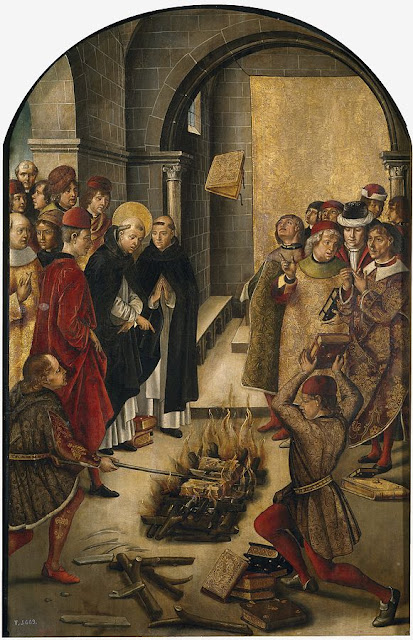St. Dominic is shown
beating himself as an atonement for his sins in Filippo Tarchiani’s painting St. Dominic in Penitence. However, if
St. Dominic tried to flail his whip in the space he is given in the painting,
he would knock over the crucifix and flowers on the altar, break the hourglass
behind him, and possibly crack the hidden skull sitting on the bottom of the
altar.
St. Dominic
in Penitence by Filippo Tarchiani. A public domain image through Open Access
for Scholarly Content.
The
Metropolitan Museum of Art, Gift of
Brian J. Brille, 2015. www.metmuseum.org/art/collection/search/440900
Why would Tarchiani paint
St. Dominic in a cramped and unrealistic space?
Perhaps the story told by
the symbolic objects cluttering the foreground was more important to Tarchiani than portraying a realistic scene.
What is the story the objects tell?
In my last post I
discussed the symbolic meaning of St. Dominic’s peculiar halo, the altar, and
the hidden skull. Today I will address the symbolism of the remaining objects in St. Dominic in Penitence and the
symbolic nature of this work as a whole.
 |
| Excerpt from St. Dominic in Penitence by Filippo Tarchiani highlighting the flowers, Photo by blog author. |
Let’s look at the
delicate vase of flowers perched on the edge of the altar. Flowers in
paintings, especially paintings from the 1600s, are loaded with significance.
Flowers shown in a
religious context represent life, death, and resurrection. There are six
flowers in St. Dominic in Penitence.
The number six symbolizes the six days of creation. There are three purple
flowers clumped in a row. The number three represents supreme power and the
holy trinity and the color purple symbolizes sorrow, penitence, and truth in
their color. The purple flowers reflect the two sides of religion seen in St. Dominic in Penitence—the truth and
power of holiness, and the sorrow and pain which comes with religious life.
This dualism is
referenced again in the two red flowers which symbolize the human and divine
nature of Christ.
The white flower stands
alone to unite these two contrasting sides into one pure and divine whole.
In this painting St. Dominic
appears to be experiencing a moment of divinity represented by the white flower
based on the light surrounding his body and his reverent gaze towards the
crucifix on the altar.
St. Dominic may have been
a saintly man, but he was still a man. The moment of pure communion shown in
this painting is only a moment. St. Dominic was obliged to return to the dark
and murky realm of humanity represented by the shadows in St. Dominic in Penitence.
 |
| Pope Innocentius III excommunicating the Albigensians (left), Massacre against the Albigensians by the crusaders (right). A public domain image from the 14th century. Source. |
St. Dominic was no
stranger to the messiness of human life. He lived during the bloody crusade
the Catholics fought from 1209-1229 against the Albigenses, a group of heretics.
However, St. Dominic brought some of the peace seen in St. Dominic in Penitence to the chaos of the crusade. Despite being
on the antagonistic Catholic side of war, St. Dominic did not physically fight
against the Albigenses. Instead he worked to protect all people from the violence
of the war by providing them with food and shelter.
 |
| Excerpt from St. Dominic in Penitence by Filippo Tarchiani highlighting the window, Photo by blog author. |
St. Dominic’s ability to
influence people without resorting to force is represented by the window in the
right-hand corner of St. Dominic in
Penitence. No light enters the painting through this window, but instead
the window may allow the light surrounding St. Dominic to shine out upon the
world.
St. Dominic’s persuasive
power is also demonstrated by the way our gaze travels around St. Dominic in Penitence. St. Dominic
himself, the illuminated focus of Tarchiani’s work, draws the eye first, just
as St. Dominic the man might draw a person in by his saintly life and teaching.
Then, our eyes follow St. Dominic’s gaze to fall upon the crucifix on the
altar, representing how St. Dominic led his followers to Christ. The crucifix
faces St. Dominic and following its direction and our eyes return to the saint.
This action could symbolize St. Dominic’s disciples being led to live a saintly
life through following the teachings of Christ.
 |
| Excerpt from St. Dominic in Penitence by Filippo Tarchiani highlighting the hourglass and books, Photo by blog author. |
Outside of the light
surrounding St. Dominic and underneath the window on top of some closed books
is an hourglass. The hourglass represents the time and the passing of human
life. The closed books the hourglass rests on symbolize unknown knowledge. The
hourglass and the closed books in St. Dominic in Penitence bring us back to the
frailty of this painting. Just as one movement from St. Dominic’s whip could
break the objects surrounding him and shatter the peace of this painting, so
the reality of human life could end without notice. There is inevitable
destruction lurking in St. Dominic in
Penitence, but in spite of this destruction or even because of it, St.
Dominic appears in a moment of divine bliss.





